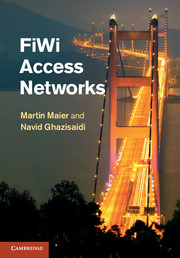Book contents
- Frontmatter
- Contents
- List of figures
- List of tables
- Preface
- Acknowledgments
- Part I Introduction
- Part II Fiber access networks
- Part III Wireless access networks
- Part IV FiWi access networks
- 10 RoF vs. R&F networks
- 11 Architectures
- 12 Network planning and reconfiguration
- 13 Techno-economic analysis
- 14 Network coding
- 15 Optical and wireless protection
- 16 Hierarchical frame aggregation
- 17 Routing and QoS continuity
- 18 Smart grid communications
- References
- Index
11 - Architectures
from Part IV - FiWi access networks
Published online by Cambridge University Press: 05 January 2012
- Frontmatter
- Contents
- List of figures
- List of tables
- Preface
- Acknowledgments
- Part I Introduction
- Part II Fiber access networks
- Part III Wireless access networks
- Part IV FiWi access networks
- 10 RoF vs. R&F networks
- 11 Architectures
- 12 Network planning and reconfiguration
- 13 Techno-economic analysis
- 14 Network coding
- 15 Optical and wireless protection
- 16 Hierarchical frame aggregation
- 17 Routing and QoS continuity
- 18 Smart grid communications
- References
- Index
Summary
In this chapter, we review recent radio-over-fiber (RoF) and radio-and-fiber (R&F) based fiber-wireless (FiWi) network design proposals and discuss previously addressed challenges. Beside cell-based RoF networks, we briefly describe a number of FiWi network architectures, which can be classified based on their wireless access technologies: WiMAX orWiFi. Table 11.1 summarizes previously proposed WiMAX and WiFi based FiWi network architectures. While passive optical networks (PONs) can be widely found in FiWi networks, wireless mesh networks (WMNs) have been used rarely so far. As we will see shortly, different challenges have been addressed such as routing and wireless channel assignment, which can be performed completely either in the wireless domain by the base station (BS) or access point (AP), or by an optical network element, e.g., central office (CO) or optical line terminal (OLT). The level of provided quality-of-service (QoS) largely depends on the performance of the implemented routing and resource management algorithms, including bandwidth allocation and channel assignment algorithms with absolute or relative QoS assurances. Reconfiguration is another previously addressed challenging issue that involves resource management in the wireless and/or optical part. For instance, as explained in greater detail below, in the unidirectional ring/PON architecture of Table 11.1, highly loaded optical network unit-wireless gateways (ONU-WGs) may be assigned to a lightly loaded PON by tuning their optical transceivers to the wavelength assigned to the lightly loaded PON, resulting in a decrease of network congestion and packet latency.
- Type
- Chapter
- Information
- FiWi Access Networks , pp. 127 - 137Publisher: Cambridge University PressPrint publication year: 2011



